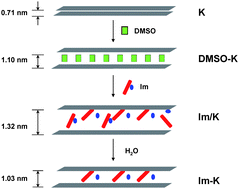This work reports the preparation and characterization of a new nanohybrid material obtained by the grafting of an organic cation, namely 1-(2-Hydroxyethyl)-3-methylimidazolium, on the interlayer surfaces of kaolinite by utilizing a dimethylsulfoxide (DMSO) kaolinite intercalate as starting material. The chemical modification process involved the in-situ displacement of DMSO by the imidazolium salt, followed by the grafting under carefully controlled melt reaction conditions. The structure of the resulting material was characterized by X-ray Diffraction (powder and oriented sample), thermal analysis (TG, DTG and DTA), FTIR, as well as by 29Si and 13C MAS NMR spectroscopy, that demonstrated the covalent binding of imidazolium cations on the kaolinite internal surfaces. Ion-exchange and permeation properties of this new nanohybrid material were tested upon its deposition onto the surface of a glassy carbon electrode (GCE), by means of multisweep cyclic voltammetry towards the preconcentration of thiocyanate species. Upon stabilization, the voltammogram signal of the GCE coated with the imidazolium-grafted kaolinite was increased in comparison to the signal obtained at the bare GCE for a thiocyanate solution. This was attributed to the accumulation of thiocyanate anions by the positively charged organoclay material due to favourable electrostatic interactions. No electrochemical signal was observed at the GCE coated with unmodified kaolinite. When hexacyanoferrate was used as probe, in strong contrast to what was obtained in the case of thiocyanate, the peak currents obtained at the clay modified electrode were essentially similar to those recorded at the bare GC electrode, showing that this functional two-dimensional material has selective anionic recognition properties.

You have access to this article
 Please wait while we load your content...
Something went wrong. Try again?
Please wait while we load your content...
Something went wrong. Try again?


 Please wait while we load your content...
Please wait while we load your content...